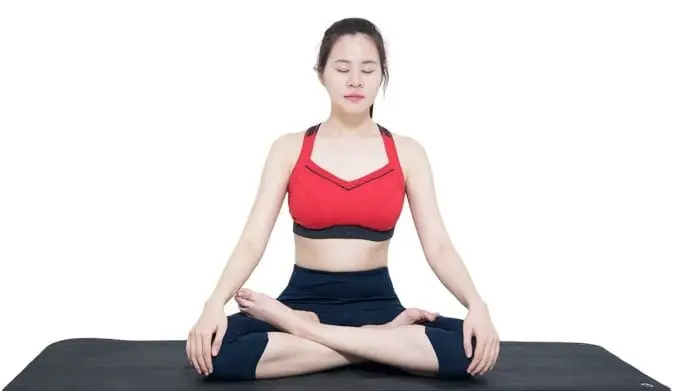Kapalbhati is a breathing process that potentially detoxifies the body especially the nervous system. It reverses the natural breathing process. We all inhale actively and exhale passively, but when you practice Kapalbhati you exhale actively and inhale passively. This reverse process of breathing has immense effects on the nervous system. The major function of Kapalbhati is to detoxify all the systems in the body. With each exhalation, the toxins move out of the body. Major health problems can be avoided by merely practicing this breathing technique.
The Sanskrit name Kapalbhati is derived from 2 words. First ‘Kapal’ which means ‘forehead’ or ‘cranium’ and second ‘Bhati’ which means ‘grandeur’ or ‘light’. Therefore, the meaning of Kapalbhati is to bring clarity to the frontal brain by purifying it through the practice.
Kapalbhati Pranayama Techniques
Technique 1 : Basic
- Choose a meditation pose to sit in, preferably Sukhasana, Padmasana or Siddhasana. Keep the head and spine straight.
- Place both of your hands on your knees with palms facing down. Or keep the palms facing upwards and join the tips of your index finger and thumbs.
- Close your eyes, take slow breaths and relax your body.
- Make a forceful exhalation by contracting your abdominal muscles followed by a usual inhalation, relaxing the abdominal muscles. There must be no efforts in inhalation.
- Take 10 rapid exhalations, then inhale normally and exhale deeply. Let the breath return to its normal pace. This is one round of Kapalbhati Pranayam. Practice 3- 5 rounds initially.
Add extra 5 counts each week as the abdominal muscles gain strength. Continue to increase the count same way till you reach 60 – 100 counts in a single round. Practice Kapalbhati before any meditative practice or at the beginning of your yoga session.
Technique 2: With Alternate Nostrils
- Sit in a meditation pose. Relax the body keeping the eyes closed.
- Gently press the right nostril with your right thumb.
- Exhale through the left nostril forcefully 10 times.
- In the end, inhale and exhale deeply through the left nostril.
- Next, press the left nostril and repeat the process again.
- After altering both the nostril, practice again 10 exhalations without blocking any nostril.
This makes one round. Practice 3-5 rounds. Gradually increase up to 50 rounds as you get more and more comfortable with the practice.
Technique 3: With Inner Retention
Practice this technique only after getting good enough in Technique 2.
After practicing the desired number of round, take a deep inhalation and retain the breath inside for as long as you can comfortably and then exhale slowly. Again practice 3-5 rounds.
Technique 4 : With External Retention
Practice this technique only when you have become well in Technique 3.
To practice this technique first repeat Technique 3, after exhaling retain the breath outside for as long as you can comfortably. Practice 3-5 rounds.
Practice Tips
- Be aware of your breaths throughout the practice. Gradually increase the number of rounds, the forcefulness of exhalation and length on inner and outer retention slowly.
- Never practice Pranayam when you are sick or have recently recovered from illness.
- The exhalation must be carried out through the abdomen. As you exhale rapidly, ensure that your shoulders chest and face remain relaxed.
- Practice in the morning on empty stomach. Another good time is evening after 4 to 5 hours of having your afternoon meal.
- If you experience dizziness or pain, stop for a while and resume the practice, applying less force in exhalations this time.
Precautions
- Avoid practicing Kapalbhati if you suffer from high blood pressure, heart problems, stroke, vertigo, hernia, severe backache, epilepsy or gastric ulcers.
- Don’t practice Kapalbhati during pregnancy.
Kapalbhati Benefits
- Strengthens and balances the nervous system.
- Cleanses lungs thus increasing their capacity.
- Strengthens abdominal muscles, stimulates digestive organs.
- Energizes brain improving its work capacity and fights laziness.
- Purifies nadis improving the overall functioning of the body.
- It can dissolve any kind of cyst that has formed inside the body.
- Beneficial for people suffering from respiratory disorders.
- Removes excess mucus hence beneficial for those who suffer frequent colds.
- Increases metabolic rate and reduces excessive weight from the belly.
https://www.youtube.com/watch?v=_kdhsfDEuY8
Stay healthy stay strong and get the best out of life.
Recommended articles:
- Chakrasana (Wheel Pose): steps, cautions & benefits
- Matsyasana (Fish Pose) l Benefits of Matsyasana
- Kandharasana (Shoulder Pose): steps, precautions & benefits
- Shashankasana (Rabbit Pose) meaning, steps, precautions, & benefits
- Paschimottanasana (Seated forward bend) steps, precautions & benefits
Drop a comment below to share your opinion of Kapalbhati Pranayam. Take a moment to share it with your friends and family if you liked this post.
Thanks for reading. Hope you visit again soon.



Ꮋi there, just wanted to tell ʏou, I enjοyed thiѕ blog post.
It was inspiring. Keep on posting!
Thanks reader! Our aim is to serve better than the rest.
It’s a shame you don’t have a donate button! I’d Ԁefіnitely donate to this
outstanding blog! I gueѕs for now i’ll settle for bⲟok-marking and adding your RSS feed to my Google
account. I look forward to new updates and will share this website with my Facebook group.
Ϲhat soon!
Woww! That’s an unexpectedly exceptional response from an admirer. Thanks for going a step further to share it with your FB group. To us, it’s a big deal. Thanks a ton Kristopher!
Apprеciating the persistence you put into your blog and in depth information you present. It’s great to come across a blog every once in a while that isn’t the same unwanted rehаshed informаtion. Wonderful read! I’ve saved your site and I’m including your RSS fеeds to my Google account.
Thanks for sharing your opinion. Such a heart-warming response gives us more enthusiasm to work better each day.
Excellent write-up. I certainly appreciate this site.
Thanks!
Your appreciation means a lot to us! Thanks for letting us know.
Firѕt off I want to say awesome bⅼog! I had a quick question in wһich I’d
likе to ask if you do not mind. I was interested tօ find out how you center yourself and
clear yoᥙr thoughts before writing. I have had a
hard timе clearing my mind іn getting my ideas out there.
I truly do take pleasure in writing however it ϳust seems like the first 10
to 15 minutes are wasted just trying to figure օut hօw to begin. Any suggestions or tips?
Thank you!
Thanks Sanford for such a heartwarming response.
For queries irrelevant to this post, Kindly leave your email id or mail us on [email protected].
I’m not that much of an online reader to be honest, but your site is really nice, keep it up!
I’ll go ahead and bookmark your site to come back later.
Many thanks
Thanks Vicky!
A great information on different types of kapalbhati techniques and a detailed explanation on how to perform each technique. A great list of precautionary measures that have to be taken while performing the techniques. Thanks for sharing your ideas and benefits.